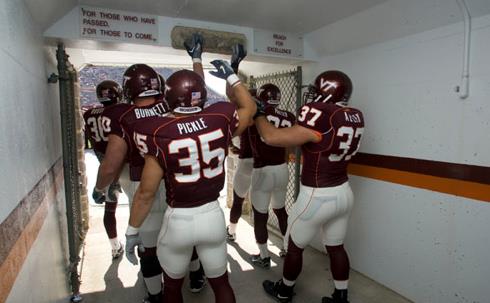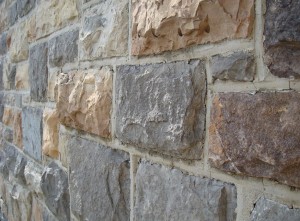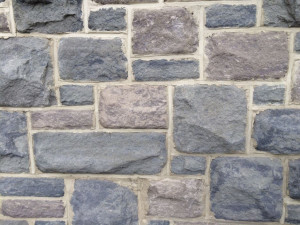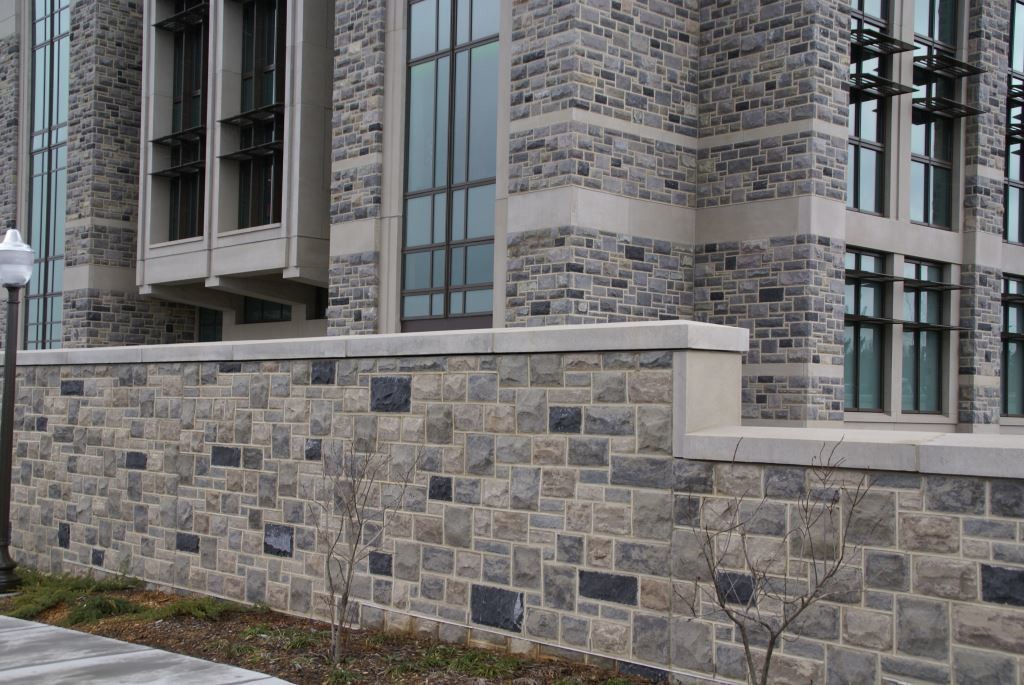Arriscraft Innovation Rescues a Legacy at Virginia Tech

At many universities, beloved symbols emerge from regional character and sometimes by pure chance. Through a determined allegiance, these icons become enmeshed with a school’s identity, often remaining unchanged for generations. At Virginia Tech, the term “Hokie” originated around 1896, when O.M. Stull won a cheer contest (pocketing five dollars); his cheer began with “Hoki, Hoki, Hoki, Hy” – and a legacy was born.
The most common use of “Hokie” refers to students and alumni, but “Hokie stone” is an equally long-held term. The first Hokie stone was quarried in 1899 (near Blacksburg, Virginia) and was used on the campus YMCA. By the 1950s, the same quarry was used exclusively for Virginia Tech and the school purchased it from a local family in 1975, in an effort to preserve their source.
 |
|
Hokie stone is dolomite limestone (found in the Appalachian Mountains) formed from calcium and magnesium carbonate and occurs in muted shades of grey, brown, black, red, and pink. |
But, as with any quarry, stone colors change over time. In recent years, the quarry colors have strayed from the original Hokie stone and Virginia Tech planners realized the distinctive colors they’d enjoyed for generations had seriously depleted. Because of the insurmountable cost of opening a new quarry and complying with remedial regulations, Virginia Tech was left with a finite supply.
Discovering an alternative stone product would take time and careful restrictions were put on their existing supply, offering it only for the most prestigious projects. Remarkably, an unrelated construction project would connect the university with their long-term solution. Around 2005, Virginia Tech chose Arriscraft’s Renaissance® stone for the base of the Student Services Building (providing a classic, pedestal base). With the understanding that Arriscraft manufactured many Building Stone styles in natural finishes and colors, the university contacted the company a few years later. Virginia Tech sought a cost effective option for a secondary campus building. A collaboration that would rescue their Hokie stone legacy began in planning the Corporate Research Park Building 25.
Arriscraft masonry experts combined two standard colors and sizes of Citadel® Building Stone to provide a representation of original Hokie stone. The Arriscraft team also carefully developed a bond pattern that closely resembled the existing one. Reviewing the finished building, the collaboration team felt that further customization could create a near 100% match. A strong hope emerged that Arriscraft could not only provide a cost-effective solution for secondary buildings, but also a virtually perfect Hokie stone replica for principal areas of the campus.
 |
| Arriscraft custom “Hokie” stone blend. Cumberland Building Stone is a classic, tumbled style in natural colors, ideal for historical matching. |
The second iteration of the replica stone used Cumberland Building Stone, which provided additional stone sizes with the same tumbled, historical style. Through in-house color development, Arriscraft created a new Cumberland color, Rockport Grey, to match existing Hokie stone tones. Using both Building Stone styles, various standard colors and the new custom color, Arriscraft’s masonry expert, Bryan Lloyd, put the pieces together and recreated the Hokie stone bond pattern. A series of sample walls were reviewed by the school architect, in the office and on-site, before a final match pattern was selected. Arriscraft also provided a second blend with includes 4-5% of the quarried black stone; this distinctive pattern is used on the most key buildings on campus.
Today, this custom blend is offered ongoing to Virginia Tech and is available to other commercial customers; some alumni have used the Arriscraft stone on their personal residences. Since 2011, the Arriscraft “Hokie” stone blend has been used on the Virginia Tech Visitors and Administration Center, a new office building on Turner Street (which is leased to the school for office use) and on landscape feature walls for the Human A.G. & Biosciences Building.

In partnering with Arriscraft, Virginia Tech is now able to design freely with their beloved “Hokie” stone. In fact, because Arriscraft stone is only a small upcharge to using brick, the school can actually extend their unique look throughout the campus, on new, secondary buildings, on restoration projects and feature areas. The university immediately recognized cost savings using Arriscraft versus quarried stone; the manufactured stone is approximately 1/3 of the cost and it installs at 100 square feet per day versus 40 square feet per day.
In addition to supply and cost advantages, Arriscraft Building Stone performs like quarried stone providing superior durability to other manufactured products. Arriscraft’s patented manufacturing process uses only natural materials (plus color pigments) and replicates how stone is created in the earth. The result is an authentic, naturally grainy appearance and texture, plus through-body color for on-site cutting and dressing.
Arriscraft’s collaborative approach, backed with industry-unique customization capabilities, solves many historical matching challenges – most of which originate from quarry color depletions and the high costs of acquiring and installing quarried stone. Several universities in North America have also discovered that Arriscraft Building Stone provides a cost effective solution for “historical” stone, as well as unparalled matching capability, enabling them to extend their brand as campuses grow and as years pass on.
Invigorated by the opportunity to continue its legacy far into the future, Virginia Tech’s staff architect and facility planners met with Arriscraft, in late 2014, to discuss several projects that are in planning stage. These include an airport hanger, entry walls and noise barriers for freeway changes around the campus. Clearly the Arriscraft solution has not only rescued the Hokie stone legacy, but also allowed a proud university to extend their brand far beyond what they might have imagined.
† Source: http://www.facilities.vt.edu/ops/quarry/
